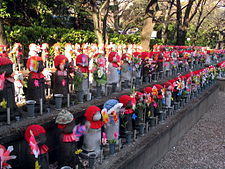Mizuko kuyō
Mizuko kuyō ( 水 子 供養 mizuko kuyō , German: " Water Child Memorial Ceremony ") is a ceremony practiced in Japan after miscarriages , stillbirths or abortions . Although rites for the unborn have long been known in Buddhism, today's custom only became popular since the 1970s and does not go directly back to traditional ideas. Reasons for the rite include the grief of the parents, the desire to save the soul of the fetus , feelings of guilt after an abortion or fear of being punished by a spirit of revenge .
Word meaning
Mizuko ( 水 子 ), literally “water child”, is the Japanese word for a stillborn baby, originally also used for children who died prematurely, while kuyō ( 供養 ) refers to a funeral ceremony. The characters for Mizuko can alternatively be read in the on-reading suiko and originally mean a Dharma name ( kaimyō ) that was given after death.
development
The mizuko kuyō, which is usually performed by a Buddhist priest, is used to make sacrifices to Jizō , a child-protective bodhisattva . It is historically related to miscarriages, but also abortions and so-called “postnatal birth control”, in which the community tacitly accepted infanticide not only out of need and poverty, but also to secure prosperity.
In today's Japan, mizuko kuyō is present again, although it is unclear to what extent the ceremonies practiced today are linked to historical forms. Until well into the 21st century, the ceremony was ostensibly related to birth control due to a lack of sex education and the lack of contraceptives. For example, the birth control pill was not fully legalized in Japan until 1999, while the abortion industry was flourishing.
ceremony
Elements of the ceremony vary depending on the temple or Buddhist school or are individually adapted. Temples usually offer for a donation to place a Jizo statue in the temple garden, which in the absence of a grave can be a place of remembrance. She is dressed in a red cloak and cap, and parents can decorate the statue with objects from the child. The ceremony is performed either by the parents together or by one parent, not necessarily the mother. The form of commemoration can vary from a one-off celebration to monthly or annual commemorations.
Some elements in the ceremony are similar to those of the funeral rites for the deceased, which are called senzo kuyō ( 先祖 供養 ): The priest looks at the altar and invokes various Buddhas and Bodhisattvas. Mantras are recited to invoke and praise Jizo. The Heart Sutra and the 25th chapter of the Lotus Sutra are often used, the latter is also known as the " Avalokiteshvara Sutra", which means the Indian version of Jizōs. In the name of the grieving child, offerings are made to the Buddhas, typically food, drinks, incense sticks or flowers. The ceremony is ended by giving a Buddhist name kaimyō and sometimes a Jizō statue is placed at the temple.
criticism
Although this custom has been publicly recognized since the 1970s, there are concerns and critical voices accusing the temples of wanting to benefit from the misfortunes of women and families. American religious scholars criticized the fact that for this purpose the fear stemming from the Japanese belief that the spirits of the dead might take revenge for mistreatment was specifically conjured up and exploited. Other researchers oppose that the temples only meet the needs of the people.
Comparable practices
A similar custom can be found in Taiwan today : yingling gongyang . Modern Taiwanese custom emerged in the mid-1970s and became particularly popular in the 1980s. The custom is based on both traditional elements from the Han Dynasty and Japanese custom, but is perceived as a custom imported from Japan. The modern practice is attributed to the problems of modernization, e.g. B. growing population, urbanization and shrinking family size, and the changing attitudes to sexuality, which first showed in Japan and later in Taiwan.
Individual evidence
- ↑ Anzai Ikuro (安 斎 育 郎): Rei wa aru ka ( 霊 は あ る か) . Kodansha, Tokyo 2002 (Japanese).
- ^ A b c d Bardwell Smith: Buddhism and Abortion in Contemporary Japan: Mizuko Kuyo and the Confrontation with Death . SUNY press, Albany, NY 1992, ISBN 0-7914-0758-6 .
- ↑ a b c Susanne Fromanek: Mizuko kuyō: Modern forms and historical backgrounds of the Buddhist death rituals for unborn babies in Japan. 2006, accessed January 5, 2020 .
- ^ Page Brookes, Anne. (1981). Mizuko kuyō and Japanese Buddhism. . Japanese Journal of Religious Studies, 8 (3-4), 119-47. Retrieved April 2, 2006.
- ↑ Martin, Elaine. (1996). Rethinking the Practice of Mizuko Kuyo in Contemporary Japan: Interviews with Practitioners at a Buddhist Temple in Tokyo Rethinking the Practice of Mizuko Kuyo in Contemporary Japan: Interviews with Practitioners at a Buddhist Temple in Tokyo. (No longer available online.) December 12, 2007, archived from the original ; Retrieved April 3, 2006 .
- ^ Marc L. Moskowitz: The Haunting Fetus: Abortion, Sexuality, and the Spirit World in Taiwan . University of Hawaii Press, 2001, ISBN 978-0-8248-2428-0 .
- ^ Charles B. Jones, Review of Moskowitz, Marc L., The Haunting Fetus: Abortion, Sexuality, and the Spirit World in Taiwan. H-Buddhism, H-Net Reviews. August, 2002.
- ↑ Fang-Long Shih: Review of "The Haunting Fetus: Abortion, Sexuality, and the Spirit World in Taiwan" . In: The China Quarterly . tape 171 , September 2002, p. 765-767 .
